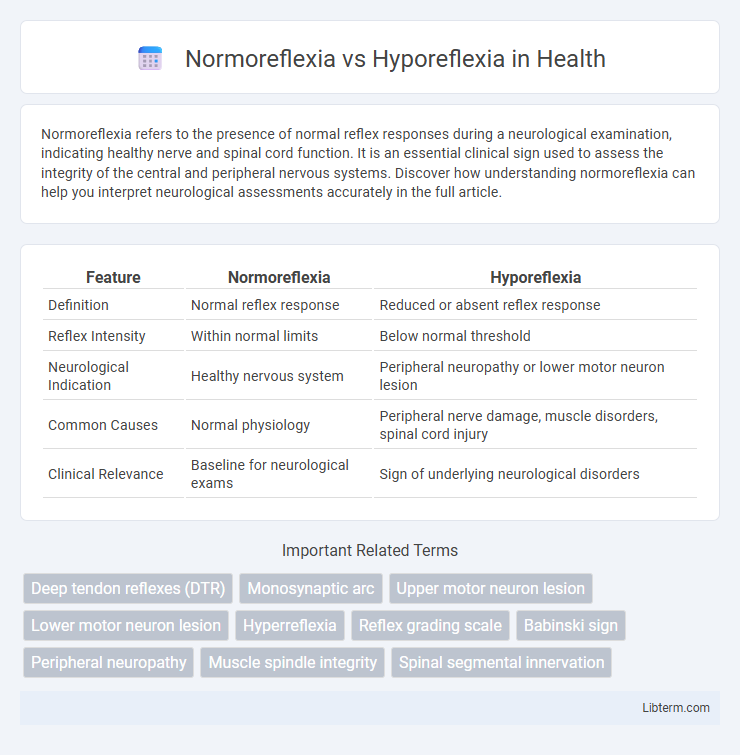Normoreflexia refers to the presence of normal reflex responses during a neurological examination, indicating healthy nerve and spinal cord function. It is an essential clinical sign used to assess the integrity of the central and peripheral nervous systems. Discover how understanding normoreflexia can help you interpret neurological assessments accurately in the full article.
Table of Comparison
| Feature | Normoreflexia | Hyporeflexia |
|---|---|---|
| Definition | Normal reflex response | Reduced or absent reflex response |
| Reflex Intensity | Within normal limits | Below normal threshold |
| Neurological Indication | Healthy nervous system | Peripheral neuropathy or lower motor neuron lesion |
| Common Causes | Normal physiology | Peripheral nerve damage, muscle disorders, spinal cord injury |
| Clinical Relevance | Baseline for neurological exams | Sign of underlying neurological disorders |
Introduction to Reflexes: Understanding the Basics
Reflexes are automatic, involuntary responses triggered by sensory stimuli, essential for maintaining bodily functions and protecting against injury. Normoreflexia refers to the presence of normal reflex responses, indicating healthy neural pathways, while hyporeflexia represents diminished reflex actions, often signaling peripheral nerve damage or muscle disorders. Evaluating reflex integrity is crucial in diagnosing neurological conditions and understanding the functional status of the nervous system.
What is Normoreflexia? Definition and Mechanism
Normoreflexia refers to the normal reflex response characterized by appropriate muscle contractions following a stimulus, indicating intact sensory and motor pathways. This physiological mechanism involves the proper functioning of the reflex arc, including sensory receptors, afferent neurons, spinal cord integration, efferent neurons, and effector muscles. Normoreflexia signifies healthy neurological function without impairment in reflex conduction or synaptic transmission.
Understanding Hyporeflexia: Causes and Significance
Hyporeflexia refers to diminished or absent reflex responses often caused by peripheral nerve damage, neuromuscular diseases, or spinal cord injuries affecting the reflex arc. This condition can indicate underlying pathologies such as diabetic neuropathy, Guillain-Barre syndrome, or radiculopathy, highlighting the importance of thorough neurological evaluation. Identifying hyporeflexia assists clinicians in diagnosing the severity and localization of neurological impairments.
Key Differences Between Normoreflexia and Hyporeflexia
Normoreflexia refers to the presence of normal, brisk deep tendon reflexes, indicating intact sensory and motor pathways in the peripheral nervous system. Hyporeflexia, in contrast, is characterized by diminished or absent reflex responses, often signaling peripheral nerve damage, neuropathy, or lower motor neuron lesions. Key differences include the reflex response amplitude, with normoreflexia showing typical reflex strength, while hyporeflexia presents reduced reflex activity due to disrupted afferent or efferent neural pathways.
Clinical Assessment of Deep Tendon Reflexes
Deep tendon reflexes (DTRs) are clinically assessed to evaluate neurological function by tapping tendons with a reflex hammer and observing muscle contractions. Normoreflexia indicates normal reflex response, suggesting intact sensory and motor pathways without neurological dysfunction. Hyporeflexia, characterized by diminished or absent reflexes, often points to peripheral nerve injury, lower motor neuron lesions, or muscle disease, guiding clinicians in diagnosing underlying neuromuscular conditions.
Common Conditions Associated with Normoreflexia
Normoreflexia, characterized by normal deep tendon reflexes, is commonly observed in healthy individuals and can be associated with conditions such as mild peripheral neuropathy or well-controlled chronic diseases like diabetes mellitus. It typically indicates intact reflex arcs involving the sensory nerve, spinal cord, and motor nerve pathways, distinguishing it from hyporeflexia, which involves diminished or absent reflexes seen in peripheral nerve injuries or neuropathies. Clinical evaluation of normoreflexia helps differentiate normal neurologic function from pathological states that affect reflex response.
Medical Disorders Linked to Hyporeflexia
Hyporeflexia, characterized by diminished or absent reflexes, is commonly linked to peripheral neuropathies, including diabetic neuropathy and Guillain-Barre syndrome, where nerve damage disrupts normal reflex arcs. Spinal cord injuries and certain neuromuscular disorders like myasthenia gravis also present with hyporeflexia due to impaired signal transmission between nerves and muscles. In contrast, normoreflexia indicates normal reflex responses, which typically exclude these pathological conditions and suggest intact neuromuscular function.
Diagnostic Procedures for Reflex Abnormalities
Diagnostic procedures for normoreflexia and hyporeflexia primarily involve clinical examination using a reflex hammer to assess deep tendon reflexes, with hyporeflexia indicating diminished or absent reflex responses suggesting peripheral nerve or lower motor neuron lesions, while normoreflexia reflects normal reflex activity. Electromyography (EMG) and nerve conduction studies provide detailed evaluation of nerve and muscle function to identify underlying neuropathies or radiculopathies contributing to hyporeflexia. Imaging techniques such as MRI of the spine or brain may be used to detect structural causes affecting reflex arcs, aiding in differentiating central from peripheral reflex abnormalities.
Treatment Approaches for Reflex Dysfunction
Treatment approaches for Normoreflexia target underlying causes such as metabolic imbalances or neurological disorders, often involving pharmacological interventions like corticosteroids or antispasmodics to normalize reflex activity. Hyporeflexia management focuses on addressing nerve damage or peripheral neuropathy through physical therapy, nerve repair techniques, and vitamin supplementation, particularly B-complex vitamins to support nerve regeneration. Both conditions benefit from individualized rehabilitation programs emphasizing muscle strengthening and proprioceptive training to restore functional reflex responses.
When to Seek Medical Advice: Normoreflexia vs Hyporeflexia
Normoreflexia indicates normal reflex responses, typically requiring no immediate medical attention unless accompanied by other neurological symptoms. Hyporeflexia, characterized by diminished or absent reflexes, warrants prompt medical evaluation to identify potential underlying conditions such as peripheral neuropathy, spinal cord injury, or neuromuscular disorders. Seek medical advice when reflex abnormalities are noticed alongside muscle weakness, sensory changes, or persistent numbness.
Normoreflexia Infographic

 libterm.com
libterm.com